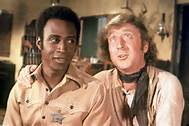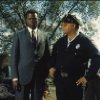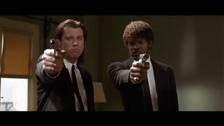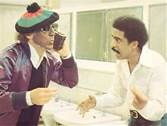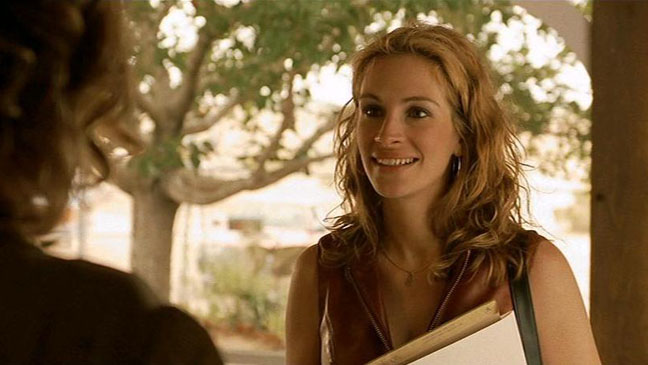When mixing black and white movie characters as either friends or foes on the big screen should not produce any gray areas at all. Whether amiable or adversarial the pairing of interracial tandems makes for an interesting sociological study in cinema where tension, togetherness, stereotypical profiling and mutual or reluctant acceptance makes for some captivating film fodder.
Sure, in many ways it is an overused cliched in the movies to produce racial tandems for the sake of the entertainment to allow the creative juices to overflow. In Salt and Pepper: Top 10 Black and White Movie Tandems we will take a look at various “salt and pepper” teams as they come together in the name of law and justice, hostile necessity, friendly frivolity or professional attachment to bring movie audiences a sense of adventure and curiosity in the name of comedic or dramatic license. Maybe you have your favorite cultural coupling that fits the theme of a celluloid “salt and pepper”twosome?
The Salt and Pepper: Top 10 Black and White Movie Tandems are (in alphabetical order according to film titles):
1.) Bart and Jim from Blazing Saddles (1974)
Writer-director Mel Brooks’s riotous mid-seventies western satire Blazing Saddles certainly took a bite out of skewering the Old West as well as sharply commenting on the race relations of the buddy-buddy genre in off-kilter fashion. Blazing Saddles was comically edgy, blunt and downright hysterical with its off-base parodies concerning racism and round-up rowdiness on the frontier, From the token black sheriff proclaiming “Where all the white women at?” to a monosyllabic Neanderthal punching out a horse with a brute fist you knew that Brooks’s brilliant warped mind was at work.
Bart (Cleavon Little) is the cunning black sheriff hired to lawfully look after the prejudiced townsfolk by a scheming big-shot political pest Hedley Lemar (Harvey Korman) that feels the minority law enforcer will distract the town from his corruptible hidden agenda. When a good-hearted, soft-spoken and fast-drawing gunman Jim (Gene Wilder) arrives on the scene and befriends Bart they present a problem to Lemar and his devious henchmen as they did not expect the black lawman to overcome his overwhelming circumstances dealing with a narrow-minded town that has suddenly accepted the black man behind the badge. Thankfully, the teamwork of Bart and Jim overcome the larcenous Lemar and his miserable minions as “brothers from different mothers”.
2.) Cleopatra Jones and Mommy from Cleopatra Jones (1973)
The blaxploitation genre in the early to mid-1970’s served as guaranteed box office gold for the urban audience to appreciate their brand of heroes and anti-heroes of color on the big screen. In the wake of the successful reception of 1971’s Shaft with ultra-cool male model-turned-actor Richard Roundtree the bright idea to come up with a female version of the Shaft formula was born. Enter stunning female model-turned actress Tamara Dobson. She was the gorgeous butt-kicking ebony queen that was Hollywood’s answer to the black action stud club in the aforementioned Roundtree, Jim Brown, Jim Kelly, Ron O’Neal and Fred Williamson that ruled the ubiquitous blaxploitation scene.
The late Dobson starred as United States Special Agent Cleopatra Jones whose mission in destroying a poppy field she burned down did not sit well with the curly red-haired Mommy (Oscar winner Shelley Winters), an unhappy druglord not thrilled with Cleo’s efforts to cut into her blossoming drug-trafficking business. Hence, the vengeful Mommy–through her connections with crooked cops and other authority figures–sets out to eradicate Cleopatra Jones and teach the boisterous black beauty with a badge a dangerous lesson. Obviously the the menacing Mommy does not know who she is messing with at all, does she?
3.) Cher and Dionne from Clueless (1995)
Ah, the trials and tribulations of high school life for chic young girls in the mid 1990’s. However, this is not just any ordinary high school in the country but that of Beverly Hills High where keeping up appearances and staying within relevance of your peers is essential. Hey, on second thought that sense of urgency is universal in every high school around the globe. Still, it is posh Beverly Hills so sticking out like a sore thumb adds more pressure one can imagine, right?
Cher (Alicia Silverstone) and Dionne (Stacey Dash) are Clueless writer-director Amy Heckerling’s pretty protagonists trying to cope with the daily social struggles of the high school grind as they bask in superficial materialism while not wanting to jeopardize their privileged standing among their elite peers. It is quite instinctual for both Cher and Dionne to expose a preppy wardrobe, rich regional lingo and glistening hairdos but can they learn to showcase something really meaningful such as their true hearts?
4.) John “Joker” Jackson and Noah Cullen from The Defiant Ones (1958)
Stanley Kramer’s late 50’s prison escape drama The Defiant Ones pulled no punches in its depiction of racial hostility. It did, however, manage to mend the fences in an unassuming friendship that was born out of desperation and the taste for constant freedom. Some found The Defiant Ones as unrealistic and exploitative racial propaganda. Whatever the sentiment was regarding Kramer’s chain gang caper it made audiences stand up and take notice.
When a prison truck accident occurs both chain gang prisoners in John “Joker” Jackson and Noah Cullen (Tony Curtis and Sidney Poitier) escape and remain on the run as they try to duck and dodge the authorities that are hot on their trail. Jackson is white and Cullen is black. Both fugitives loathe one another with a heated passion. Jackson bombards Cullen with some of the most divisive racial epithets he musters up on the spot. Cullen wants so badly to bury Jackson and his mean-spirited mouth. The reality is that both escapees must rely on each other despite the deepened disdain that lingers between them. Gradually both men realize their tolerance and respect for one another.
5.) Detective Virgil Tibbs and Gillespie from In the Heat of the Night (1967)
Northern black cop Virgil Tibbs is innocently waiting for a train in Sparta, Mississippi en route to heading back home to Philadelphia. He is detained in Sparta in the wake of a death involving a big-shot businessman whose murder Tibbs was erroneously blamed for committing. Once Tibbs is cleared of all suspicions he is asked to conduct a murder investigation to help out the small-time Sparta police force led by racist Southern white police chief Gillespie (Rod Steiger). This is the premise behind Norman Jewison’s superbly intense crime caper In the Heat of the Night.
Interestingly, Tibbs is the top-notched expert in solving homicides as he is tall, polished, perceptive and well-informed. Naturally Tibbs is the kind of “colored” man that narrow-minded stout-shaped Gillespie (and the people of Sparta) are not used to witnessing concerning a capable professional black man and his crime-solving wits. Reluctantly, Tibbs works the murder case with Gillespie while encountering some resistance and hostility along the way. Soon, Gillespie learns to respect Tibbs’s immense talent as a fellow law enforcer with superior capabilities and Tibbs sees Gillespie beyond his bigoted Bubba sheriff persona.
6.) Martin Riggs and Roger Murtaugh from Lethal Weapon (1987)
Richard Donner’s Lethal Weapon was one of the immensely popular buddy cop movies in the late 80’s that encouraged a wave of copycat mismatched (and multicultural) teaming that invaded the big screen with high-octane shenanigans. The on-screen high-wire antics that Mel Gibson and Danny Glover brought to the Lethal Weapon movie franchise was energizing fun and frenzy (although becoming increasingly repetitive as the sequels piled up).
Los Angeles Police Department cops Martin Riggs (Gibson) and Roger Murtaugh (Danny Glover) were on the edge and drove both their superiors and pursued bad guys crazy. The younger and athletic Riggs was a loose cannon and lover of his beloved comedy team The Three Stooges. Riggs never got over the loss of his beloved wife he grieved silently. The older and often flustered Murtaugh was a family man and by-the-book cop that looked forward to retirement without incident…that was until Riggs showed up as his partner and made his crime-fighting career all the more colorful and chaotic.
7.) Samantha Caine/Charly Baltimore and Mitch Henessey from The Long Kiss Goodnight (1996)
Renny Harlin’s The Long Kiss Goodnight gave a distinctive twist on the “salt and pepper” genre when he decided to team his then-wife Geena Davis with the Oscar-nominated Pulp Fiction star Samuel L. Jackson in his action-packed thriller about a suburban wife-turned-secret agent extraordinaire trying to figure out her past identity before it ends up terminating her for good.
Suburban Pennsylvania housewife and mother Samantha Caine (Davis) leads a charmed life as a teacher. She absolutely adores her 8-year old daughter Caitlin and is a modern-day June Cleaver in the kitchen. However, a freak knock on her head turns into an identity crisis of sorts when she starts to remember bits and pieces of her past life at Charly Baltimore, a skilled and deadly top secret agent–a curvaceous James Bond if you will. Now her old outfit wants to shut her up completely.
Samantha/Charly hires dime store PI Mitch Henessey (Jackson) to restore her memory and help her get to the bottom of who is trying to silence her indefinitely. Witty verbal exchanges, animated gunplay and explosions, exaggerated bad guys and the male/female-black/white tandem of Jackson and Davis make for the off-the-wall suspense in the impishly pleasing The Long Kiss Goodnight.
8.) Vincent Vega and Jules Winnfield from Pulp Fiction (1994)
The year 2014 marks the twentieth anniversary that filmmaker Quentin Tarantino delivered 1994’s toxic and imaginative Pulp Fiction to the big screen that single-handily revived John Travolta’s career and made film character actor vet Samuel L. Jackson a recognizable household name. Importantly, the salt and pepper pairing of Travolta and Jackson dutifully gave a penetrating and perverse pulse to the riveting and innovative Pulp Fiction.
Jules (Jackson) and Vincent (Travolta) are the hired hitmen for Marsellus Wallace (Ving Rhames). Whether sent out to protect and entertain Wallace’s wife Mia (Uma Thurman) or collect on a late payment from neglectful punks the gun-toting thugs are darkly humorous and horrific. Jules is the no-nonsense Bible scripture-quoting, implosive one that contemplates one day laying down his gun for some clarity with the intent to roam the world like Kane from TV’s Kung Fu. Vincent is the soft-spoken and gently dense one who we learn meets an untimely death while sitting on the pooper. Together, Vincent and Jules are the hedonistic hitmen that effectively headlined Tarantino’s whacked-out world of underbelly undesirables in his masterpiece crime caper.
9.) George and Grover from Silver Streak (1976)
Not since Dean Martin and Jerry Lewis in the mid-1940’s to mid-1950’s has there been a more dominant comedy duo so highly anticipated at the box office than the pairing of outrageous Gene Wilder and the explosive nuttiness of the late Richard Pryor.
Arthur Hiller’s comedy thriller Silver Streak began the Pryor-Wilder teaming on the big screen with hilarious results. Of course this would be followed by other movie collaborations that would reunite Wilder and Pryor in the Sidney Poitier-directed Stir Crazy from 1980, the less received Arthur Hiller-directed 1989 farce Hear No Evil See No Evil and finally 1991’s Maurice Phillips-directed Another You.
Silver Streak introduces ditzy book editor George (Wilder) and Grover (Pryor) on a long distance train ride from Los Angeles to Chicago. When George thinks he witnesses a man being thrown off the train to meet a hasty death he decides to look into the matter and solve this macabre mystery. With occasional thief Grover at his side to help protect his endangered hide and a romance blossoming with female passenger Hilly (Jill Clayburgh) George must overcome the possibilities of being the next body thrown onto the rail from the speedy train. Plain and simple…Wilder and Pryor were knee-slapping movie magic.
10.) Atticus Finch and Tom Robinson from To Kill a Mockingbird (1962)
In the film adaptation of Harper Lee’s Pulitzer Prize-winning To Kill a Mockingbird (movie directed by Robert Mulligan) we find brave and justice-minded white lawyer Atticus Finch (Oscar winner Gregory Peck) defending a disabled black man named Tom Robinson (Brock Peters) from an erroneous rape charge from the lying and scared lips of a white woman Mayella Ewell (Collin W. Paxton) making the trumped-up accusation.
Atticus is fighting an uphill battle (not to mention poor Tom) to convince the courtroom that his persecuted client is innocent of the bogus charges despite the shaky and inconsistent claims made by the delusional Mayella. The hostile atmosphere and period of time certainly does not favor Tom Robinson–it is a small racially-divided Southern rural Alabama town in the early 1930’s where the blood-thirsty community wants Tom’s head on a silver platter. Atticus’s defense of Tom causes the manufactured harm done to his kids around town not to mention marking Finch as a “sellout” and “traitor” to his people. To Kill a Mockingbird remains one of the most important American literary and cinematic achievements to shape the perception of race and the judicial system for the ages.
Honorable Mention:
Agent Jay and Agent Kay from Men in Black (1997)
Skip Donahue and Harry Monroe from Stir Crazy (1980)
Jack Cates and Reggie Hammond from 48 Hours (1982)
–Frank Ochieng


